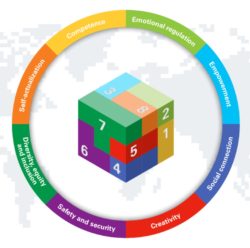It’s an inspiring – and necessary – growing trend: looking at well-being through the lens of children’s own digital experiences. Necessary because, in order to understand how good or bad young people’s experiences are in digital spaces, we have to talk with them – about their experiences now and their desires and designs for better ones going forward.

“There is no universal agreement as to how to define – and, therefore, how to measure – well-being,” write the authors of the just-released report “Responsible Innovation in Technology for Children” (#RITEC), much less how to support, even enhance, well-being in digital spaces. Even as the metaverse is already under rapid construction and “the digital” plays “an increasingly important role in children’s development,” according to UNICEF. There is a vacuum to fill.
So the authors – UNICEF’s research group and Western Sydney University’s Young & Resilient Research Center, research groups that make a practice of gaining deep understanding from, with and for kids around the world on many subjects – asked more than 300 children aged 7-18 in 13 countries what well-being means to them. They were building on a 20-year-old approach to this subject called “subjective well-being.” [Their consultations with the children followed a lit review, an analysis of survey data from 34,000 kids and teens 9-17 in 30 countries, and interviews with parents and designers of children’s spaces in five countries.]
With the help of those 300+ kids and teens, the authors arrived at an eight-part framework that they hope will help adults assess the impact of digital experiences on children’s well-being.
I’ll let you read the report for those (p.16) and here just touch on how young people view well-being, as shared with RITEC’s authors: that…
- Well-being is whole-child, whole-community: physical, mental, emotional and social. On the social part, “well-being is helping people,” and Indonesian young person said. Well-being is “having my friends’ support,” said one from Tunisia. It’s also “about inner tranquility,” an Uruguayan young person said.
- Safety and creativity can’t be mutually exclusive; both underpin well-being. The former enables the latter. As for the latter, an Albanian youth told the researchers, “When we are creative, we do new things, we learn and become wiser [and this makes us] happier.”
- Self-actualization is integral: Children tie well-being to developing a sense of self and self-acceptance and purpose. Children in Tunisia designed these into a game “lets you be in ‘control and overcome difficulties … [helping you] to feel proud … to feel I exist and am important.” In Taiwan: To have well-being is to “love yourself and love everybody.”
- Agency, competency, empowerment are too: An Albanian child said their group’s game was designed “to make people feel that they have things under control and that they can face the challenges”; a UK young person said playing enables them to “control the world” and “feel successful, unlike how I feel in my actual life”; and many young participants indicated they loved playing and designing games that gave them opportunities to gain knowledge and master new skills.
- Inclusiveness, diversity and fairness are fuel – everybody should be able to join the play and play spaces, not just kids in certain countries, economies and socio-economic brackets. A child in Iraq said lack of access “is stressful.” A Brazilian young person said online games need to have “several types of skin tones, hair, nose shape, mouth shape, etc; have strong female characters, LGBT+ … offer several languages and [welcome] people from different countries.”
- Escape, release, emotional regulation are indispensable: Opportunities to escape the challenges and busy-ness of everyday life, relax and even be positive or inspired support well-being. A Bulgarian youth said that playing games “makes me [feel] relaxed … [as] it distracts me from real life problems.”
These insights represent just the first phase – the definition phase – of a huge study aimed at providing tools and guidance to both industry and policymakers by the end of 2023. Industry will have actual tools – indicators of well-being, ways to measure it and recommended design features from Phase 2’s researchers at New York University, City University of New York, University of Sheffield and the Australian Research Council Centre of Excellence for the Digital Child. That will in turn provide policymakers with regulatory guidance.
It’s a research model that can be replicated in simple ways at home and school – wherever there are children – at a time when they deserve supportive, open-hearted communication from the people who help them thrive.
Having a “fragmented understanding of well-being is challenging [right now] … a time when actors from across all sectors are looking at means to promote positive, human-centric outcomes and opportunities from digital technology and innovation,” the authors write.
Our children will help us.
Related links
- About the RITEC report. Click on “FRAMEWORK” at the top of the page to see both the full graphic and descriptions of the eight elements of the framework.
- US-based guidance for consulting with youth from the Social Media & Adolescent Health Research Team (SMAHRT) at the University of Wisconsin: “Youth Advisory Boards: Perspectives and Processes”
- “Garnering Youth Expertise” starts on p. 22 of the HX (Human Experience) Report, published this past January by All Tech Is Human. In it, we (I had the privilege of co-authoring and -editing the report) explain the principle and context of “Nothing about us without us” for young people and present the views of youth advisers to a number of organizations, including SMAHRT.
- Guidance from New York-Based Joan Ganz Cooney Center: “Models of Youth-Adult Collaboration for Public Media” and a companion report “Navigating Youth Media Landscapes: Challenges and Opportunities for Public Media”
- Youth views on another vital topic: “Our Rights in the Digital World: A Report on the Children’s Consultations to inform UNCRC General Comment 25” and my post about that

[…] Children’s own views on wellbeing: Global study […]